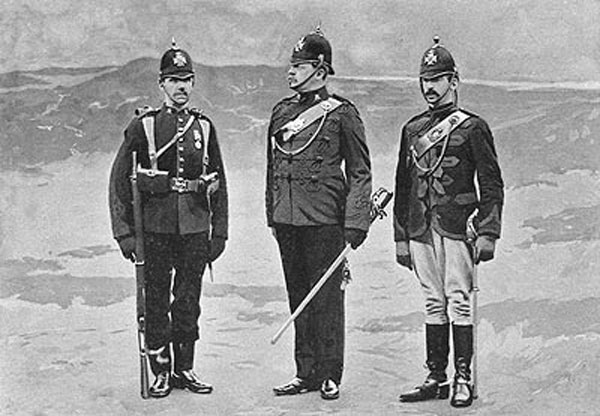The 4th Volunteer Battalion
The Queen's (Royal West Surrey Regiment)
 |
| (Click to enlarge) 4th Volunteer Battalion The Queen's (Royal West Surrey) Regiment. |
The unit was raised in Lambeth on 13th March, 1860, as The 19th Surrey Rifle Volunteer Corps, having its headquarters at 71, New Street, Kennington Park. A reorganisation of The Rifle Volunteer Corps took place in 1880 and the 19th became the 7th and later the 8th Corps. Finally, it was designated as the 4th Volunteer Battalion, Queen’s (Royal West Surrey Regiment), the change being made in March, 1883.
The photograph shows a Private, Regimental Sergeant Major, and an Officer of the battalion, all wearing dark rifle green tunics, with scarlet facings and dark green trousers, the officer wearing light grey, or buff coloured breeches, with field boots and spurs.
The head-dress worn by all three is the 1878 Home Service pattern helmet, the helmet plate, a black Maltese cross and crown with a silver or white metal lamb in the centre. The Officer and R.S.M. both wear a shoulder-Belt with a black metal plate in the form of a wreath, with the lamb in silver. Buttons and collar badges were black.
The Private is wearing Slade-Wallace equipment in black leather and appears to be armed with a Martini-Henrxact date of the photograph is not known, from the evidence available, it would appear to have been taken in, approximately, 1895.
In 1900, many members from the battalion served in the Boer War with a Volunteer Company of the City of London Imperial Volunteers.
In April, 1903, the 4th Volunteer Battalion transferred to the Territorial Force as the 24th (County of London) Battalion, The London Regiment (The Queen’s). The 1st/24th served throughout the Great War on the Western Front, the 2nd/24th in France, Salonika and the Middle East.
A Victoria Cross was awarded to Lance-Corporal L.J. Keyworth, 1st/24th, for bravery on the night of 25th-26th May 1915, at Givenchy.
In 1937, the 24th became the 7th (Southwark) Battalion, The Queen’s Royal Regiment and both the 1st and 2nd/7th battalions fought in France, Belgium, North Africa, Italy and North-West Europe.
Related
